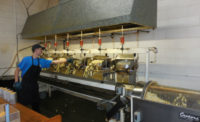|
Falstaff: I will not lend thee a penny. |
| William Shakespeare, The Merry Wives Of Windsor Act 2, scene 2, 2–5 |
To the Mayans and Olmecs, the empty oyster shell represented the concept of zero, a central component of any numbering system. Although empty, the hollow oyster shell simultaneously symbolized the gift of life, core to existence itself.
For the Greeks and Romans, the oyster proved to have more earthly associations. In addition to being a beloved delicacy, it symbolized love, virility. Afterall, it was Aphrodite, the goddess of love, coming out of the sea on an oyster shell. With the Chinese, oysters have always played a key role in cuisine, which may explain their signficance in dreams as well. Thus, the Middle Kingdom has viewed oysters as a symbol of good fortune, good luck.
In Shakespeare’s Merry Widow, Ensign Pistol’s opportuntistic reference to the oyster as well as his willingness to open it with his sword has evolved into a catchall for seizing what the world has to offer, although the Bard’s original intent suggests Pistol’s approach involved more sinister means.
In choosing the oyster shell as a symbol for this year’s Global State of the Industry, the emphasis encompasses many of the elements cited earlier: the sweetness of life, the allure of chocolate in romance and passion, the latent good fortune inherent in all things confectionery and the continued growth and opportunity within emerging as well as mature markets.
The most recent assessment of the global confectionery market, as determined by Euromonitor International’s analysts, pegs total sales at $185.5 billion. Western Europe accounts for the largest portion of this sweet piece of pie, with nearly a third of all sales at $58.6 million. North America follows with a 20% slice, trailed closely by Asia Pacific markets at 17.2%, with Latin America and Eastern Europe also holding significant portions.
Perhaps the most interesting numbers, however, regarding the global confectionery segment aren’t from a year ago; rather they lie in the crystal ball column, portending what’s ahead for 2016. Closer examination of compounded annual growth rates re-emphasize the continued emergence of Asia Pacific, Latin American and Middle East/African markets, with respective 3%, 3.5% and 5.5% CAGR gains.
It’s not that these forecasts come as a surprise. Last year’s global confectionery overview (See Candy Industry, June 2011) singled out the BRIC quartet (Brazil, Russia, India & China) as countries leading the emerging markets phenomenon. Brazil, India and China in particular were demonstrating robust growth rates.
What’s important to emphasize in our review of the CAGR numbers isn’t only the gains, but similarily the lack of significant growth in Western Europe and North America, which projects sluggish 1% and 1.4% CAGR advances.
As always, it’s important to qualify that such numbers must be taken with a certain grain of sugar; after all Western Europe and North America account for more than half of all of the world’s confectionery sales.
The very nature of such mature and large markets allows for a broad range of subsegments and niches within established categories. That, in turn, allows for an equally broad range of sale fluctuations within a specific category context.
When one takes a closer look at the major confectionery segments — chocolate, sugar and gum — the numbers reinforce an existing reality, the dominating role chocolate plays in global sales. Although Euromonitor’s prognosticators don’t foresee any major shifts down the road, one can’t help but think that the continued acceptance of chocolate by Chinese and Indian consumers will affect that number dramatically in the coming years.
The uptick in gum also warrants commentary, since a 2.7% CAGR during the next five years isn’t anything to scoff at. Indeed, in a recentInnovations in the Global Confectionery Market report by Leatherhead Food Research, the London-based authors noted that “the global market for chewing gum continues to perform well, driven by the emergence of new flavors and concepts such as liquid-filled gum.”
A closer breakdown of the segment numbers by region pinpoints the hot spots by category. Chocolate looms large within the Asia Pacific, Latin America and Middle Eastern/Africa regions, albeit still falling short in total dollars versus Western Europe.
Turkey, for example, has attracted considerable interest from chocolate equipment suppliers during the past several years, attesting to both the domestic as well as international opportunities for several Turkish confectionery manufacturers. A return to normalcy in several “Arab Spring” nations as well as Libya and Egypt would significantly increase confectionery consumption within those markets.
Those same markets also show an increased appetite for sugar and gum confections, with the Middle East/Africa region projected to post double-digit gains for gum sales. That forecast reflects what many have been saying about not only the Middle East as post-Iraq war stability appears to settle in, but also about Africa, whom many observers believe is on the verge of an economic boon.
The reality of such shifts can be seen in the listing of top global national markets. And while the United States remains the largest single confectionery market in the world, Brazil is projected to pass up both the U.K. and Germany in 2016.
China nearly overtakes Russia for the fourth ranking while Japan, France and Italy all slip in consumption as demographics — a low birth rate and aging population — work against increased candy sales. Mexico, with its influx of younger consumers, will continue to grow as a marketplace for sweets.
Upon closer examination of the U.S. confectionery market, chocolate remains dominant with a 56% share of all sales in 2011, sugar and gum accounting for 31% and 14%, respectively. A recent report issued by Mintel projects moderate growth for the chocolate catgory, 12% during the next five years through 2016.
Seasonal sales drive chocolate gains
Seasonal chocolate showed the highest sales gains within the U.S. chocolate confectionery segment with $4.4 billion, making up 23.7% of category sales. Interestingly, about a quarter of all global chocolate launches in 2011 had a seasonal positioning.
“This year has proved to be a real hot-bed of activity for Easter chocolate,” says Marcia Mogelonsky, director of insight for Mintel Food and Drink. “Seasonal chocolate is, if anything, more recession resistant than the overall market, as the products have broad appeal as gifts for a wide range of recipients, from friends to relatives and co-workers.”
One of the reasons behind the Easter push involves manufacturers coming up with more novel items for the holiday.
“Easter has consistently led other holidays in innovation — and in sales — as it is a holiday with a strong affinity for confectionery through gift baskets, egg hunts, and other family-focused traditions,” Mogelonsky explains.
Another trend highlighted by the Mintel reports involves package size. Specifically, smaller format packages (bags, bars and boxes weighing less than 3.5 oz.) saw sales grow 18.5% from 2009-11 — the largest growth of all packaging varieties. And, larger format packages (bags, bars, and boxes weighing more than 3.5 oz.) also performed well during the same time period.
However, as manufacturers respond to consumer demand for smaller pack sizes and less calories, this could change. For example, Mars said earlier this year that by 2013 all its chocolate would have 250 calories or less per serving.
This pendulum-swinging penchant for large and small sizes also factors into consumer behavior regarding where they buy confections. Although about three-fourths of consumers continue to purchase their chocolate at supermarkets, there are plenty of other retail formats for consumers to consider: mass merchandisers, drug stores, convenience stores, speciality stores, vending machines and non-traditional locations, such as stores selling housewares, tools and building supplies and liquor.
“Due to the strong competition among retail outlets, channels will need to make sure they have the widest selection at the most competitive prices,” the Mintel report states.
Consumer behavior changing
Not only are consumers channel surfing where they purchase confections, they themselves are modifying their habits. Fortunately, 97% of U.S. households eat chocolate and candy, the Mintel report states, citing Experian Simmons NCS.
“Further fueling the opportunity, there is a growing interest in snacking, which represents a strength in the market, ” Mintel’s authors write.
Surprisingly, candy consumption amongst children (aged 6-11) is down while adults and teens show an increase. That means parents — a typical source for candy among children — will be a key marketing group to those who want to buck the trend and increase sales to the industry’s most famous age group.
The good news is, everyone still seems to love eating chocolates, regardless of gender, age and income.
However, what kind of chocolate and what they’re willing to pay for it does vary.
Women are more likely than men to indulge in snack-sized offerings and are more likely than men to associate eating chocolate with positive experiences such as personal reward (celebratory candy bar after the gym, ladies?), whereas men are focused on price.
Meanwhile, higher income earners are most likely to eat boxed chocolates.
And, the highest household income earners ($150K+) are most likely to associate chocolate with a personal reward — an indication that marketing premium, personal products to these consumers could present an opportunity for growth.
Mintel says consumers recognize the nutritional value of premium products, and view them as a “nutritive reward, rather than an empty indulgence.” The report advises marketing premium products as gifting options.
As for the age-old debate between milk and dark chocolate, older consumers and those of higher household incomes tend to prefer dark chocolate, but milk chocolate is still the favorite choice among 57% of consumers, with dark and white chocolate coming in a distant second and third respectively.
The same cannot be said about sugar-free chocolate, which faced the biggest sales declines during this period, down 6.9% from 2009-11 and 27% from 2006-11.
Mintel attributes the decline to a lack of product innovation and to competition — the multitudes of healthy snacking options outside the confectionery category are hindering sugar-free chocolate sales. Moreover, sugar alternatives haven’t quite caught on with mainstream consumers.
What’s catching on are increased product introductions. According to Symphony IRI’s New Product Pacesetters report, the number of new products posting sales of more than $7.5 million in their first year has almost tripled in 2011.
M&M’S Pretzel lead all confections last year, bringing in $58.5 million to Mars’ stable of confectionery brands. It, together with Snickers Peanut Butter Squared as well as Wrigley 5 React and Wrigley Extra Dessert Delights proved powerful drivers for the confectionery powerhouse. In total, the company could boast of eight Pacesetter launches last year.
All in all, confectionery and gum new products accounted for 19% of all food launches with Pacesetter status last year. Between 2002 and 2011, the category only averaged around 7% of all new food launches having Pacesetter status.
It’s unclear whether the U.S. confectionery industry can repeat such a performance in 2012. Nonetheless, confectionery manufacturers, be they in the United States or elsewhere, certainly have the potential to do so. As Ensign Pistol noted, it’s just a matter of prying open the oyster and scooping up the treasure.
*Candy Industry intern Kawther Albader also contributed to the article.












